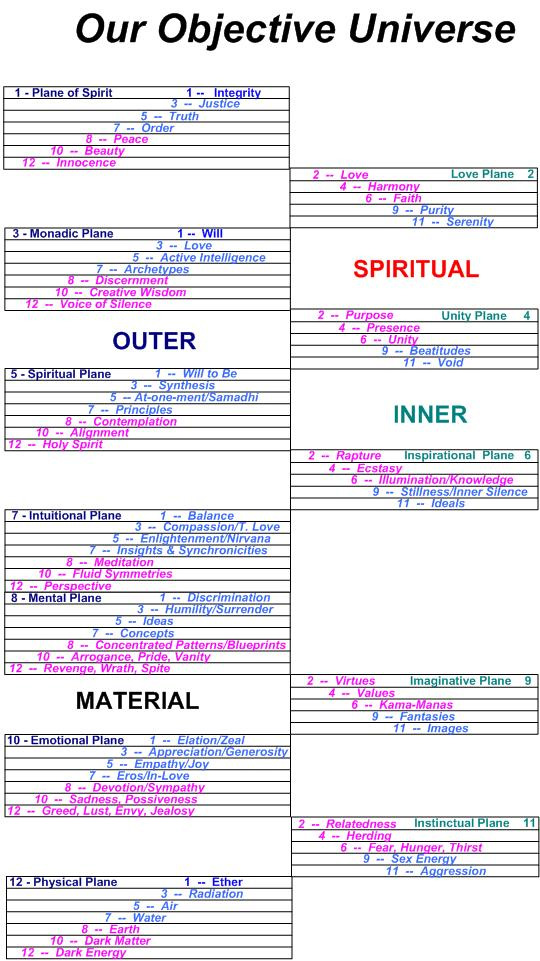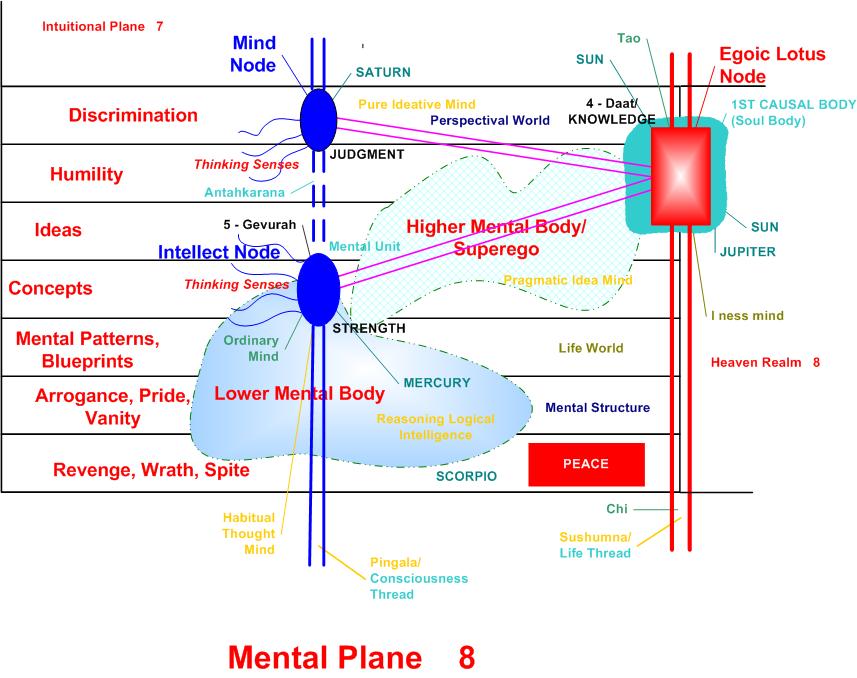 Our lowest two mental senses are those of reasoning. Although the term reasoning has had as much misuse as the term mind, I choose to use the definition "normal mental powers" to be inclusive of reasoning capabilities. Deductive reasoning includes the faculty by which we "reduce all experience to rational formulas." It is "any process of drawing a conclusion from a set of premises."
Our lowest two mental senses are those of reasoning. Although the term reasoning has had as much misuse as the term mind, I choose to use the definition "normal mental powers" to be inclusive of reasoning capabilities. Deductive reasoning includes the faculty by which we "reduce all experience to rational formulas." It is "any process of drawing a conclusion from a set of premises."
 Inductive reasoning is a little more difficult to comprehend. Spinoza defined this reasoning as "the perception of the order of things." Induction is "reasoning from particular facts or individual causes to a general conclusion." A key to inductive reasoning is inference. Webster's Dictionary uses the words "cause, bring about, indicate indirectly" and "imply" as keywords in defining infer.
Inductive reasoning is a little more difficult to comprehend. Spinoza defined this reasoning as "the perception of the order of things." Induction is "reasoning from particular facts or individual causes to a general conclusion." A key to inductive reasoning is inference. Webster's Dictionary uses the words "cause, bring about, indicate indirectly" and "imply" as keywords in defining infer.
 Simplistically, inductive reasoning is thinking that moves backwards as a process, while deductive reasoning moves forward as a process. Inductive reasoning derives the implied cause from the effects. Deductive reasoning deduces the results or effects from various related factors.
Simplistically, inductive reasoning is thinking that moves backwards as a process, while deductive reasoning moves forward as a process. Inductive reasoning derives the implied cause from the effects. Deductive reasoning deduces the results or effects from various related factors.
 Our third thinking sense is logical or analytical thinking. Logic uses various systems to "link knowledge with knowledge." According to the Dalai Lama, "we can also reflect on the ultimate nature of phenomena, their empty nature, by using logical reasoning to ascertain the nature of reality." Therefore, the faculty of analytical thinking is an elaborate process of analytical observation and synthetic construction into a form of "conceptual" knowledge.
Our third thinking sense is logical or analytical thinking. Logic uses various systems to "link knowledge with knowledge." According to the Dalai Lama, "we can also reflect on the ultimate nature of phenomena, their empty nature, by using logical reasoning to ascertain the nature of reality." Therefore, the faculty of analytical thinking is an elaborate process of analytical observation and synthetic construction into a form of "conceptual" knowledge.
Take a Journey through our
Spirit/Matter Universe
Our Current Evolutionary Playground
of the Mind
by Jef Bartow
 The highest aspect of our material existence has been traditionally labeled our mind. Within our Spirit/Matter universe, our mental nature resides within the outer objective Mental Plane. The reason for the title of this article is that this part of human existence is the primary focus of our evolutionary development at this time. Our imaginative, emotional, instinctual and physical parts of our Personality were the focus of human evolution in the far distant past. This does not mean that we don't continue to refine and transform these parts of ourselves, only that humanity has not fully developed its mentality in the past.
The highest aspect of our material existence has been traditionally labeled our mind. Within our Spirit/Matter universe, our mental nature resides within the outer objective Mental Plane. The reason for the title of this article is that this part of human existence is the primary focus of our evolutionary development at this time. Our imaginative, emotional, instinctual and physical parts of our Personality were the focus of human evolution in the far distant past. This does not mean that we don't continue to refine and transform these parts of ourselves, only that humanity has not fully developed its mentality in the past.
 This is a primary reason why we have two mental nodes, one higher and one lower. Within a past evolutionary époque, humans consciously developed the intellect node. Today, humanity is in the process of individually developing the mind node. Like our spiritual energy nodes, the mind node still represents a potential for most humans.
This is a primary reason why we have two mental nodes, one higher and one lower. Within a past evolutionary époque, humans consciously developed the intellect node. Today, humanity is in the process of individually developing the mind node. Like our spiritual energy nodes, the mind node still represents a potential for most humans.
This is why in the figure below the connection between the intellect and mind is dotted. In metaphysics, it is referred to as the antahkarana. Humans must consciously build this bridge in order to consciously receive spiritual energies into the Personality. Until then, spiritual energies descend through the central column and enter the Personality through the Egoic Lotus.
Our articles are available for reproduction for all members. Please give credit to the author.
For non-members, contact us for permission to reproduce articles.
Thinking Senses
 As has already been described, we develop senses within each Plane. Our thinking senses are the highest senses we develop as a material being. They provide our ability to interact and receive mental energies for mental processing (i.e. thinking). Our five mental senses include deductive and inductive reasoning, analytical thinking or logic, abstract thinking and discrimination. I conclude that our first three mental senses extend from the intellect node while our two highest thinking senses extend from the mind node. I am only beginning to now believe that we also have senses which extend from our Egoic Lotus node. What they are is to be determined.
As has already been described, we develop senses within each Plane. Our thinking senses are the highest senses we develop as a material being. They provide our ability to interact and receive mental energies for mental processing (i.e. thinking). Our five mental senses include deductive and inductive reasoning, analytical thinking or logic, abstract thinking and discrimination. I conclude that our first three mental senses extend from the intellect node while our two highest thinking senses extend from the mind node. I am only beginning to now believe that we also have senses which extend from our Egoic Lotus node. What they are is to be determined.
 The duality of our mentality is demonstrated by not only two energy nodes, but also by two bodies, one higher mental and one lower mental. This duality also includes our normal mental consciousness and our Ego. From the Egoic Lotus node, the Ego becomes our objective consciousness expression while the Soul becomes our subjective expression in the Heaven Realm. This multitude of dualities is what we must overcome in order to become an integral Being.
The duality of our mentality is demonstrated by not only two energy nodes, but also by two bodies, one higher mental and one lower mental. This duality also includes our normal mental consciousness and our Ego. From the Egoic Lotus node, the Ego becomes our objective consciousness expression while the Soul becomes our subjective expression in the Heaven Realm. This multitude of dualities is what we must overcome in order to become an integral Being.
 Our higher thinking faculties include abstract thinking and discrimination. The key to abstract thinking is what differentiates it from other thinking. Webster's defines abstract as "thought apart from any particular instances or material objects." Abstraction, as thinking is "forming and idea by abstracting out what is common to a variety of instances." It is a type of contemplation that ends with the creation of ideas. It comes from inspecting forms and discerning their nature and interrelations.
Our higher thinking faculties include abstract thinking and discrimination. The key to abstract thinking is what differentiates it from other thinking. Webster's defines abstract as "thought apart from any particular instances or material objects." Abstraction, as thinking is "forming and idea by abstracting out what is common to a variety of instances." It is a type of contemplation that ends with the creation of ideas. It comes from inspecting forms and discerning their nature and interrelations.
 Discrimination, as a sense or faculty, transcends normal day-to-day thinking and reasoning. Metaphysically, discrimination is what takes place between the essential and nonessential, real and unreal, Self and not-self and soul and spirit, leading to "freedom from the three worlds" (i.e. physical, emotional and mental Planes). Our sense of discrimination leads us from our material existence to the real nature of our Self and Soul. Discrimination becomes the bridge from our Ego and Personality to spiritual energies and states of consciousness.
Discrimination, as a sense or faculty, transcends normal day-to-day thinking and reasoning. Metaphysically, discrimination is what takes place between the essential and nonessential, real and unreal, Self and not-self and soul and spirit, leading to "freedom from the three worlds" (i.e. physical, emotional and mental Planes). Our sense of discrimination leads us from our material existence to the real nature of our Self and Soul. Discrimination becomes the bridge from our Ego and Personality to spiritual energies and states of consciousness.
 Central to our mental existence are concepts and ideas. Unfortunately, many use these terms interchangeably. Since many of the terms used to define ideas and concepts are the same, the key is in differentiating these two levels of thought energy. In general, ideas more relate to pure thoughts while concepts are the models developed from ideas. An idea is a mental object of some thought or knowledge. In this case object means organized energy. The idea is a singular result of processing input from our thinking senses.
Central to our mental existence are concepts and ideas. Unfortunately, many use these terms interchangeably. Since many of the terms used to define ideas and concepts are the same, the key is in differentiating these two levels of thought energy. In general, ideas more relate to pure thoughts while concepts are the models developed from ideas. An idea is a mental object of some thought or knowledge. In this case object means organized energy. The idea is a singular result of processing input from our thinking senses.
 Our concepts are derived from ideas. For example, at some point someone came up with the idea of a portable computer. In order to create a viable portable computer, certain concepts had to be developed. One concept relates to the size and shape of this computer related to other computers. Another concept had to be developed in maintaining continuous power to this computer, since it moved from place to place and many times is just in transit. A third concept in creating a portable computer related to how it could easily connect with other computers to transmit information developed independently from other computers.
Our concepts are derived from ideas. For example, at some point someone came up with the idea of a portable computer. In order to create a viable portable computer, certain concepts had to be developed. One concept relates to the size and shape of this computer related to other computers. Another concept had to be developed in maintaining continuous power to this computer, since it moved from place to place and many times is just in transit. A third concept in creating a portable computer related to how it could easily connect with other computers to transmit information developed independently from other computers.
Mental Energies/Matter
 The Mental Plane is organized similar to every other Plane. The lowest, densest and most instinctual energies comprise the lower subplanes while the most refined transformed energies “float to the top” as they say. Therefore, it's pretty easy to see how revenge, wrath and spite are at the bottom of our mental energies. I have at numerous times felt the energy of spite as a needle being poked in my eye. Each of these mental toxins is derived from an exaggerated anger or pain that formulates some form of punishment as a response.
The Mental Plane is organized similar to every other Plane. The lowest, densest and most instinctual energies comprise the lower subplanes while the most refined transformed energies “float to the top” as they say. Therefore, it's pretty easy to see how revenge, wrath and spite are at the bottom of our mental energies. I have at numerous times felt the energy of spite as a needle being poked in my eye. Each of these mental toxins is derived from an exaggerated anger or pain that formulates some form of punishment as a response.
 Another array of lower mental energies includes arrogance, pride and vanity. Each one of these is created from the developing ego and an overinflated sense of personal "I." To me, each one of these is a mental counterpart to the second lowest emotional energies of sadness and possessiveness.
Another array of lower mental energies includes arrogance, pride and vanity. Each one of these is created from the developing ego and an overinflated sense of personal "I." To me, each one of these is a mental counterpart to the second lowest emotional energies of sadness and possessiveness.
 I think is fairly easy to understand how the main energy output or results of processing our deductive and inductive reasoning are mental patterns and blueprints. In architecture, the original needs, goals and ideas become the detailed blueprints that the contractors use to create the physical structure. Deduction and induction develop the systems, patterns and networks that provide the basis for physical manifestation of an idea or spiritual reality.
I think is fairly easy to understand how the main energy output or results of processing our deductive and inductive reasoning are mental patterns and blueprints. In architecture, the original needs, goals and ideas become the detailed blueprints that the contractors use to create the physical structure. Deduction and induction develop the systems, patterns and networks that provide the basis for physical manifestation of an idea or spiritual reality.
 The model of a portable computer was developed based on the various concepts developed from one idea. From the integrated concepts in a model, the more detailed systems and blueprints become the further processing in thinking required to create a physical reality. A simple thing to understand regarding these three levels of energies is the progression from a more pure or oneness to a much greater level of complexity and intertwined density.
The model of a portable computer was developed based on the various concepts developed from one idea. From the integrated concepts in a model, the more detailed systems and blueprints become the further processing in thinking required to create a physical reality. A simple thing to understand regarding these three levels of energies is the progression from a more pure or oneness to a much greater level of complexity and intertwined density.
 Moving to the highest mental energies, we next encounter humility. From our descriptions above of abstract thinking and discrimination, they both involve release or detachment. Webster's defines humility as the "absence of …self-assertion." To humble or surrender ourselves is to release from our normal attachments to matter for something higher or more spiritual. Internalizing and expressing humility (the lack of self and ego) is how we begin to create the conscious bridge to spiritual realities (antahkarana).
Moving to the highest mental energies, we next encounter humility. From our descriptions above of abstract thinking and discrimination, they both involve release or detachment. Webster's defines humility as the "absence of …self-assertion." To humble or surrender ourselves is to release from our normal attachments to matter for something higher or more spiritual. Internalizing and expressing humility (the lack of self and ego) is how we begin to create the conscious bridge to spiritual realities (antahkarana).
uters.







